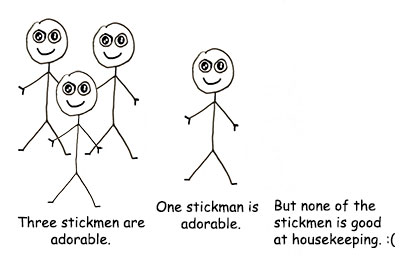
In last month’s post, I reviewed the basics of subject-verb agreement: definitions of subjects and verbs, how they agree, and common issues that arise when a phrase comes between the subject and verb and when there’s a compound subject. In today’s post, I will discuss some finer details of subject-verb agreement.
Collective, Non-Count/Mass, and Invariable Nouns
Simple, regular nouns like “bus” and “cloud” cause minimal issues with subject-verb agreement because they have clearly identifiable singular and plural forms, such as “bus-buses,” “cloud-clouds,” “eye-eyes,” and “book-books.” Usually, plurality is shown with an added -s or -es, but there are also words like person-people and mouse-mice.
Get a free sample proofread and edit for your English document.
Two professional proofreaders will proofread and edit your English document.
Collective, non-count/mass, and invariable nouns can be a little trickier. Collective nouns are nouns that name a collection of things, such as “army,” “set” (e.g., of tools), “fleet” (e.g., of ships), “herd” (e.g., of cows) , and “chorus” (e.g., of singers). Non-count/mass nouns name things that can’t be counted, like “sugar” and “water.” Invariable nouns have only one, plural-appearing form, like “scissors,” “molasses,” politics,” and “pants.” Here are the rules for each:
To my ear these both sound a bit odd, so I might tend to eliminate the construction by using a noun phrase for “staff” instead:
The Word “Data“
For a long time, the word “data” was simply looked at as a mass noun and thus took a singular verb (even though “data” is the plural of “datum”), like this:
More recently, some dictionaries and style guides have shifted to using a plural verb with data, like this:
Here are a few rules you can keep in mind to get it right with the word data:
Note that there are other nouns coming from Latin that you’ve got to be careful with because their singular and plural forms do not follow standard English patterns indicating grammatical number. So just remember that some words’ forms follow the same singular and plural patterns as “datum” and “data,” such as “medium” (“mediums” refers only to physics and sizes) and “media” and “bacterium” and “bacteria.” Make sure to use singular and plural verbs accordingly.
Dummy Subjects
In a previous post, I wrote about the dummy subject, which is the word “there” or “it” in constructions, such as, “It is nice to feel needed,” and, “There are dogs in the yard.” In the first example, “it” stands in for “to feel needed” and in the second “there” stands in for “dogs”—singular and plural subjects, respectively—so the verbs must be “is” and “are.”
Writers get into trouble at times with dummy subject constructions because they lose sight of what the dummy is standing in for and therefore use the wrong verb. Or they write as they speak, as in, “There’s chickens running around the barn!” In this case, “there” stands in for chickens (plural) so the verb must be “are,” rather than “is”: “There are chickens running around the barn!”
Even more troublesome is when there is/are constructions are used with lists, as in, “There were ten cookies, four servings of chocolate mousse, and a pie in the dessert case.” A list, by its nature, is a plurality, so the verb must be plural. Sometimes, when items in the list are singular, using a plural verb can sound awkward, as in, “There were a pie, ten cookies, and four servings of chocolate mousse in the dessert case.” As you can see, arranging the items so the plural verb (are) is by a plural noun (ten cookies) sounds much more natural.
It’s also possible to cut out the dummy subject construction entirely, such as changing, “There is a book, a pencil, and a calculator on the table” (which is incorrect, because “a book, a pencil, and a calculator” should take a plural verb), but, “There are a book, a pencil and a calculator on the table” can sound strange. So another way to avoid this problem is rearranging the sentence to avoid the dummy subject: “A book, and pencil, and a calculator are on the table.”
So it’s important to be mindful of subject-verb agreement with dummy subject sentences, and avoid using the constructions when in doubt about whether you’ve got the agreement correct.
Singulars Made Up of Plurals
Singular things made up of plural objects (a box of apples) can also be confusing. With “a box of apples,” the word “box” is the subject. Because box is singular, it takes a singular verb: “The box of apples is in the trunk.”
None Is Singular
And now for a really tricky one. There can only be one “none.” There’s no way to have multiple “nones” (outside of mathematics). So, “none” is singular. So, if you have a plural subject like “calendars,” it’s: “The new year’s calendars are on sale.” Of if your plural subject just regards some of that group, such as “three of the calendars,” it’s: “Three of the new year’s calendars are on sale.”
However, if only one of the calendars is on sale, it’s, well: “Only one of the new year’s calendars is on sale.” So the same is true for “none”: “None of the new year’s calendars are on sale.”

Proper subject-verb agreement is definitely a must have for writing situations where you are trying to present a highly professional or academic tone, so make sure to carefully proofread your writing for incorrect verb forms, or pay the professionals at ProofreadingPal to help you with that sometimes-tricky task!
Sarah P.
Get a free sample proofread and edit for your English document.
Two professional proofreaders will proofread and edit your English document.
Get a free sample proofread and edit for your document.
Two professional proofreaders will proofread and edit your document.
We will get your free sample back in three to six hours!